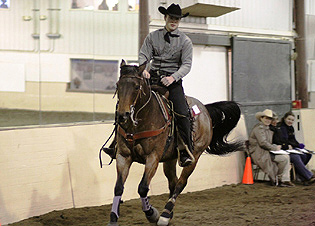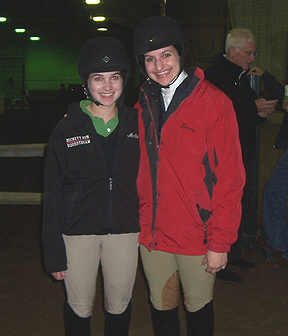|
||||||
|
LEARNING THE DIFFERENCES BETWEEN THE IHSA AND THE IEA Both the Intercollegiate Horse Show Association (IHSA) and the Interscholastic Equestrian Association (IEA) will hold separate season-ending National Championship horse shows one week apart. The IEA will hold their Nationals April 28th through May 1st in the Show Place Arena at Prince George's Equestrian Center in Upper Marlboro, Maryland while IHSA Nationals will take place May 5th through 8th in the Indoor Equestrian Event Arena at the Kentucky Horse Park in Lexington, Kentucky. It will be the second consecutive season that the IHSA has hosted Nationals at this location. Considering that one show is exclusive to riders in high school or younger while the other is exclusive to riders in college (or older) some may be surprised to learn that many people are involved with both organizations and both year-end events. If one views the IEA Nationals prize list he or she might notice that the Stewards for IEA Nationals are Bryan Bradley and Megan Taylor. Bradley will be at IHSA Nationals with several of his University of Delaware riders as will Taylor with the Cacchione Cup rider from her University of the South team. Though Towson University IHSA Coach Mehdi Kazemi does not have any of his riders going to Lexington Kazemi himself is the IEA Nationals Course Designer! With Campus Equestrian having begun to cover IEA events in 2010-11 this writer thought it might be a good time to explain the similarities and differences between the IHSA and the IEA. The IHSA was founded in 1967 and has grown from fewer than a dozen teams in the Spring of that year to over 350 colleges and universities in 2011. The number of actual registered IHSA riders may number 8,600 for the current season. Though the IHSA was officially formed in 1967 several college shows involving the same schools were held as early as 1965. Similarly the IEA name was born in mid 2002 though three year-end shows with the title 'Interscholastic Invitational' were held between the spring of 2000 and spring of 2002. Though the National show just outside of Washington, DC will be only the ninth such event in the organization's history, the IEA has grown to over 4,000 riders in this relatively short period of time. When executive director Roxane Lawrence formed the IEA she used many of the rules and regulations IHSA founder Bob Cacchione had instituted 35 years earlier: Each IEA show has a random horse draw. Riders who win a class receive seven points while riders who place second receive five, etc. There are jumping classes and flat classes at IEA hunter seat shows. There are reining and rail classes at IEA western shows. IEA teams pick point riders and turn in a point sheet prior to the start of a show. The divisions themselves have corresponding numbers (just as the IHSA refers to 'open fences' as 'class 8' in many parts of the country, the IEA refers to varsity open fences as 'class 1;' The term 'Varsity' is associated with the high school or 'upper school' riders. Class 2 is varsity intermediate fences, class 3 is junior varsity novice fences - still part of the upper school though the word 'junior' is used). Over time the IEA would be divided into Regions and Zones.
The IEA differs with the IHSA on other criteria. The IEA has separate 'Upper School' or high school and 'Middle School' teams. The Upper Schools compete in seven hunter seat divisions (open flat and fences, intermediate flat and fences, novice flat and fences and beginner; there is no level between beginner and novice) while the Middle School teams show in five divisions (same as upper school minus the two open divisions). The IEA team scoring system converts the first place teams total from a raw number to '7.' The second place team receives '5,' the third place team receives '4' and so on. If all seven point riders won for an IEA upper school team on a given day the score would be listed as '49' on the point card (the low score is NOT dropped) but for the yearly cumulative score this high point team would receive only seven points. You can have a situation where the winning team scores 49 and the reserve champion receives 25 yet history will show a 7-5 victory for the team with a 'perfect day.' Because of this point conversion process a team needs only 12 points to qualify for the post-season. Unlike the IHSA individual riders need only 15 points to qualify for an IEA Regional show. The big catch here is that IEA riders can only compete in up to Five regular-season shows to attempt to reach 15 points in one of the levels. The most fascinating 'difference' between the two organizations is perhaps the IEA rule which allows teams to cross Regional and Zone boundries to compete throughout the regular season. Back on December 18th there was a show at Mystic Valley Hunt Club in Gales Ferry, Connecticut in which 25 teams had signed up to compete. Though the show was hosted by a Zone 1, Region 4 program teams from three other regions made up eleven of the 25 entries (two of these, the Metropolitans and Carriage Stone Farm, are from Zone 2. At least four teams from Zone 1, Region 4 with relatively large rosters did not compete on the 18th). While riders can only compete five times a team may show more often, perhaps bringing a completely different group of riders from one show to the next. With riders crossing boundries so frequently (among other reasons), back numbers are assigned fresh at every IEA show. In total contrast many IHSA regions assign a rider a number at the beginning of the season which is then worn through Regionals. Excluding invitational shows, IHSA riders compete only in one region throughout the regular season, only seeing riders from other regions if they qualify through to a Zones competition and beyond. Also of importance is the rule that requires an IEA host facility to prepare to accomodate 12 rides in a division and one rider in every division for 15 teams. The circumstance which arrises from this is that the division may be split into two sections of six each, but a section of a division is illegal if it does not contain six or more riders (by contrast an IHSA class is legal - meaning the points count toward Regionals - if three or more riders are entered). Sometimes when a rider scratches from an IEA show this forces two classes originally made up of six riders to be combined into one large class of up to eleven. Because the IEA has grown faster in certain geographic areas, the comparative size of one IEA Zone to another is uneven. While Zone 1 (all of New England) is made up of four separate regions, Zone 2 (currently all of New York and Pennsylvania) is made up of only one big region. If they were combined Zones 8 and 10 would contain a fraction of the number of riders currently found in Zone 4. In order to determine how many riders and teams from each Zone advance to IEA Nationals, there is a formula based on each Zones' membership on December 31st of the current season. Though the IHSA does not currently use a formula to determine who goes on from Zones or Semifinals to Nationals (the placings themselves are the formula), the IHSA did in fact use a formula between 1973 and 1978 to determine the IHSA National Champion team. According to Lawrence there will be some changes to certain IEA Zones in the off-season. For example it is expected that Zone 2 will be divided into multiple regions. At the end of the day however, those who compete in or attend events held by either organization will tell you that things generally seem the same. Riders complete in their classes, the results of each class are announced, the next class comes in, the process repeats until the end of the day, the team totals are announced, and everybody goes home and gets ready for the next show. ---Steve Maxwell
|
||||||
|
|
||||||
|
HOME
| CONTACT US |
||||||


